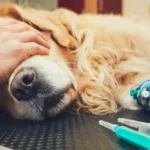Chondrosarcoma in Dogs – Chondrosarcoma is a rare but serious form of cancer that originates from cartilage cells in dogs. Ribs, bones, nasal passages, and even the trachea may be impacted by this cancerous growth. Chondrosarcoma in Dogs grows in cartilage and grows more slowly than osteosarcoma, which is made from bone, but it can still be deadly.

The cartilage, a flexible connective tissue that exists in places such as rib cages, ears, joints, noses, and the trachea, is where chondrosarcoma, a type of malignant tumor, develops. It usually occurs in the rib cage, pelvis, and nasal cavity. Chondrosarcoma can spread to surrounding tissues and organs, apart from being less aggressive than other cancers like osteosarcoma.
Chondrosarcoma in Dogs Symptoms
The location of the tumor may affect the symptoms of chondrosarcoma because it can develop in many parts of the dog’s body. Mainly, symptoms include –
Limping or lameness – Specifically, if the pelvis or limbs are affected by the tumor.
Swelling or visible mass – Around the face, joints, or rib cage.
Difficulty in breathing – If the trachea or nasal passages are affected.
Nasal discharge or bleeding – Sometimes connected to nasal cavity tumors.
Reduced performance or appetite may result from pain or sensitivity in the impacted area. See your veterinarian right away if your dog shows these symptoms because early detection is important.
Reasons and Dangers
It is still unknown what particularly causes canine chondrosarcoma. However, the following things might increase the risk of contracting this illness –
Breeds – Some breeds, like giant breeds, may be more prone due to genetic predisposition.
Age – Dogs that are middle-aged or older are diagnosed more often.
Past injuries – Tumor development may be more prone in areas with a history of trauma or chronic inflammation.
Environmental factors – Longer exposure to particular chemicals or carcinogens may be a contributing factor.
Chondrosarcoma Diagnosis
A veterinarian will commonly carry out many diagnostic tests to recognize chondrosarcoma –
Physical examination – To find any edema, lumps, or signs of pain.
Imaging – The location, size, and growth of the tumor can be decided by MRIs, CT scans, or X-rays.
Biopsy – To decide the type of tumor and decide whether it is malignant, a tissue sample is removed from the mass and inspected under a microscope.
To find out if the cancer has spread, other tests such as blood work and chest X-rays might be done.
Options for Treatment Of Chondrosarcoma in Dogs
The location, size, and rise of the tumor are some of the things that affect how chondrosarcoma is treated in dogs. The main types of treatment are made up of –
Surgery
When possible, surgical removal of the tumor is the best course of action. If the tumor is localized and has not metastasized, full surgical excision may allow for a potentially favourable prognosis. More specialized surgical methods might be needed in cases involving the nasal cavity or ribs.
Radiation Therapy
Radiation therapy can aid in reducing symptoms and shrinking the tumor.
Medication
Although chondrosarcoma is typically thought to be resistant to chemotherapy, it can still be utilized in some cases, specifically if the cancer has spread or there are not many other treatment options.
Palliative care
Palliative care for dogs concentrates on quality of life and pain management when curative treatment is not possible. This may consist of supportive care, anti-inflammatory medications, and pain management medications.
Prognosis
Location, size of the tumor, and presence/absence of metastases are the main considerations when determining the prognosis for dogs with chondrosarcoma. Dogs can live for many years after treatment if the tumor is detected early and surgically treated, specifically if it is in the limbs or ribs. Moreover, the prognosis for tumors based in more complex areas, like the spine or nasal cavity, is often more cautious.
Even after treatment, observation and check-ups are essential because reappearance is possible.
Prevention and Surveillance
Even though chondrosarcoma cannot be prevented, routine veterinary check-ups can help detect the disease early, especially in older dogs or breeds that are more prone to it. Keep an eye out for any strange lumps, lameness, or breathing difficulties in your dog, and get fast veterinary help if something unusual happens.
Conclusion
Although it is rare, canine chondrosarcoma is a case that requires immediate treatment. Various dogs can lead happy and comfortable lives with early diagnosis, suitable treatment, and constant care. To offer your pet the best care possible, always stay knowledgeable and speak with your veterinarian if you have any doubts about their health. You are not alone if your dog has been diagnosed with chondrosarcoma; veterinary experts, support groups, and internet forums can aid you at every stage of the process.
FAQs
Is it possible to treat canine chondrosarcoma?
If chondrosarcoma is detected early and surgically removed before it develops, it may occasionally be treatable. The location of the tumor and its possible for total removal, however, has a notable impact on the result. With constant care and observation, some dogs may live for many years after treatment.
How quickly does canine chondrosarcoma develop?
Compared to osteosarcoma and other bone cancers, chondrosarcoma mainly grows more slowly. By invading adjacent tissues, it can still result in severe harm. Although it rises more slowly, it is still a severe condition that requires to be treated right away.
Does chondrosarcoma cause pain in dogs?
Chondrosarcoma can indeed be painful, particularly if it affects sensitive parts like the nasal cavity or bones or joints. Dogs that are uncomfortable may limp, be reluctant to move, or become sensitive to touch in the impacted area. An important part of treatment is pain management.
Are some dog breeds more likely to get chondrosarcoma?
Chondrosarcoma may be more common in giant breeds, including German Shepherds, Great Danes, and Golden Retrievers. Age also matters middle-aged and older dogs get the majority of diagnoses. However, any breed or size may be affected by the cancer.




